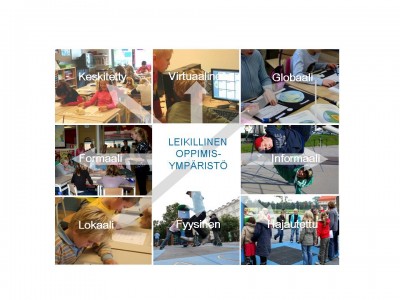Tein Leikilliset oppimisympäristöt Prezi-esityksen alunperin kurssimateriaaliksi, mutta se esittelee myös hieman näkökulmia oppimiseen, erityisesti pelillisyyden, leikllisyyden ja luovuuden näkökulmista – aihepiiriä, joka on ollut keskeisessä roolissa työskennellessäni Let’s Play ja InnoPlay -projekteissa Lapin yliopistossa.
Creative and playful learning
Learning scientists argue that deep learning is more likely to occur in complex social and technological environments. Recently, in studying learning in rich social and technological environments, researchers have referred to several types of learning, such as game-based learning, project-based learning, playful learning and learning by design or design-based learning. The playful learning environment (PLE), the research context I have been involved in, is a complex physical, pedagogical, social and cultural media environment that enables children to actively participate in curriculum-based learning by both designing and playing. Figure: Children actively participate in curriculum-based learning by designing, playing and learning in the PLE (playful learning environment). (InnoSchool Research Consortium/ http://innoschool.tkk.fi)
Figure: Children actively participate in curriculum-based learning by designing, playing and learning in the PLE (playful learning environment). (InnoSchool Research Consortium/ http://innoschool.tkk.fi)
The PLE encompasses an outdoor playground and related its equipment, technology and software used for educational purposes. It consists of indoor and/or outdoor learning activities: game creation, and games on the playground, and/or play without technology. The terms of creative and playful learning entails designing and playing in the PLE context.
I see that creative and playful learning is based on thinking, doing and physical activities, in other words, mind-on, hands-on and body-on activities. The qualities of creative and playful learning activities are summarized below (and with references better elaborated in my doctoral thesis):
1. Creativity refers to creative knowledge-building and learning creatively by using new technology and designing artifacts, games or media products. Creativity also refers to the opportunity to make discoveries and solve problems and to use one’s imagination and possibility thinking.
2. Playfulness refers to an attitude towards learning and learning through play and games.
3. Narration refers to a narrative mode of thinking and understanding as a key aspect of meaning-making. It follows from this that one way to make sense of experience and the world while learning is narratives.
4. Collaboration emphasizes knowledge co-creation and collaborative design and play processes. Collaboration with peers encourages motivation and cognitive engagement.
5. Emotions involve all human activity having a key role in thinking and learning.
6. Media richness entails the use of technology and media as a natural part of learning processes and curricula.
7. Embodiment and physical activity refer to physical learning activities and the use of the whole body in learning processes where ‘embodied knowledge’ can be achieved.
Anyway, it is needed more research in various authentic school contexts for defining and understanding better the forms of creative and playful learning.
